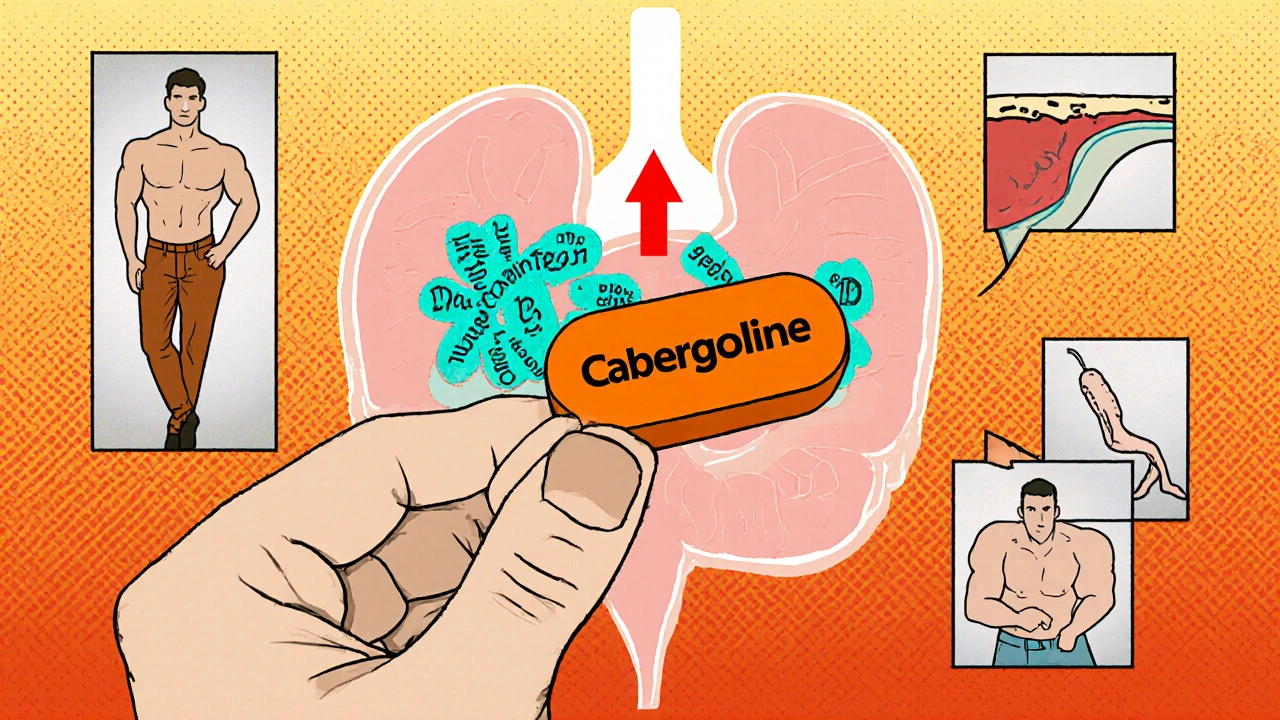Cabergoline Dosage Calculator
Calculate Your Starting Dose
When a man’s prolactin level spikes, the ripple effects can be surprising - from low libido to persistent breast tissue growth. Cabergoline is a dopamine‑agonist medication primarily used to lower prolactin levels. Understanding how this drug works, who can benefit, and what to watch for is key for anyone exploring treatment options.
What makes Cabergoline different?
Cabergoline binds to dopamine D2 receptors in the pituitary gland, telling it to dial back prolactin production. Compared with older dopamine agonists, it has a longer half‑life (about 65 hours) and can be taken twice a week instead of daily. That convenience translates into fewer missed doses and steadier hormone control.
Male health issues where Cabergoline can help
Although the drug was first approved for treating prolactin‑secreting tumors, clinicians have found several male‑focused applications:
- Hyperprolactinemia - Elevated prolactin (often above 20 ng/mL) can suppress gonadotropin‑releasing hormone, leading to low testosterone, erectile dysfunction, and decreased sperm count.
- Male infertility - In couples where the male partner shows high prolactin, normalizing the hormone often restores sperm motility and density.
- Gynecomastia - Breast tissue growth in men is sometimes linked to excess prolactin; reducing the hormone can shrink the tissue without surgery.
- Low testosterone syndrome - By lifting the prolactin block, Cabergoline can indirectly raise testosterone levels, improving energy and mood.
- Parkinson’s disease (off‑label) - Some neurologists prescribe low‑dose Cabergoline to enhance dopamine activity, although this use is not FDA‑approved for men specifically.
Typical dosage for men
Doctors usually start with a low dose to gauge tolerance. A common regimen looks like this:
- Day 1: 0.25 mg taken orally.
- Day 4: If prolactin drops without side effects, increase to 0.5 mg.
- Maintenance: 0.5 mg twice weekly (e.g., Monday and Thursday). Some patients need up to 1 mg twice weekly, but higher doses raise the risk of heart‑valve issues.
Blood work should be repeated after 4‑6 weeks to confirm that prolactin is in the target range (usually <10 ng/mL). Adjustments are made based on labs and symptom relief.

Benefits you’re likely to notice
Men who achieve normalized prolactin often report:
- Improved libido and spontaneous erections.
- Higher morning testosterone levels (average increase of 120 ng/dL in clinical series).
- Better mood, less irritability, and increased energy.
- Higher sperm count - a 30 % rise in total motile sperm has been documented after three months of therapy.
These outcomes can be life‑changing, especially for couples trying to conceive.
Potential risks and how to mitigate them
Like any medication, Cabergoline carries side effects. The most common are mild nausea, headache, and dizziness, which usually fade after the first few weeks. More serious concerns include:
- Valvular heart disease - Long‑term high‑dose use (above 3 mg/day) has been linked to valve thickening. Routine echocardiograms are recommended for anyone on therapy for longer than a year.
- Orthostatic hypotension - Standing up quickly can cause a drop in blood pressure. Staying hydrated and rising slowly helps.
- Psychiatric effects - Rarely, patients experience impulse‑control issues or mood swings. Monitoring mental health is essential.
Any new symptom should trigger a call to your provider.
Cabergoline vs. Bromocriptine: A quick comparison
| Feature | Cabergoline | Bromocriptine |
|---|---|---|
| Half‑life | ~65 hours | ~6 hours |
| Typical dosing frequency | Twice weekly | Daily |
| Peak efficacy for prolactin reduction | 95 % of patients achieve <10 ng/mL | ~80 % achieve target |
| Common side effects | Nausea, headache | Nausea, fatigue, dry mouth |
| Risk of cardiac valve involvement | Low at ≤1 mg/week, higher at >3 mg/day | Very low, but data limited |
For most men, the convenience of twice‑weekly dosing makes Cabergoline the preferred choice, provided they stay under the low‑dose threshold that keeps heart‑valve risk minimal.
Monitoring and follow‑up plan
Effective management isn’t just about picking a pill; it’s about tracking progress:
- Baseline labs: Prolactin, testosterone, CBC, liver enzymes.
- 4‑week check: Repeat prolactin; adjust dose if still >20 ng/mL.
- 3‑month review: Full hormone panel plus semen analysis for infertility patients.
- Annual echocardiogram: Only if the dose exceeds 1 mg/week or therapy extends beyond 12 months.
Keeping a symptom diary helps the clinician see patterns that lab values alone might miss.
When Cabergoline isn’t right
Not every man with a hormone issue needs this drug. Consider alternatives if you:
- Have a known allergy to ergot‑derived compounds.
- Are on anticoagulants that increase bleeding risk.
- Have uncontrolled hypertension or severe heart disease.
- Prefer non‑pharmacologic routes, such as surgery for a large pituitary adenoma.
In those cases, surgery, radiation, or a different class of medication may be safer.
Frequently Asked Questions
Can Cabergoline improve testosterone without affecting prolactin?
Cabergoline’s primary action is to lower prolactin. By removing prolactin’s suppression of the hypothalamic‑pituitary‑gonadal axis, testosterone often rises as a secondary effect. Direct testosterone‑boosting without prolactin change is uncommon.
How fast will prolactin levels drop?
Most men see a 30‑50 % reduction within the first two weeks and reach target levels by six weeks, assuming the dose is adequate.
Is Cabergoline safe for long‑term use?
When kept below 1 mg per week, long‑term safety is well documented. Higher doses require periodic heart‑valve scans.
What should I do if I miss a dose?
Take the missed tablet as soon as you remember, unless it’s within 24 hours of the next scheduled dose. In that case, skip the missed one and continue with the regular schedule.
Can women take Cabergoline for the same issues?
Yes, women with hyperprolactinemia or prolactin‑secreting tumors also use Cabergoline, often at similar doses. However, pregnancy considerations differ.
For anyone dealing with hormone‑related symptoms, cabergoline for men offers a potent, low‑frequency option that can restore balance and improve quality of life. Always discuss personal health history with a qualified provider before starting therapy.



Alex Pegg
October 21, 2025 AT 01:40Cabergoline sounds like another pharma gimmick sold to men who think a pill can fix everything.
laura wood
October 31, 2025 AT 11:40Reading through the overview, I can see how confusing hormone issues can be, especially when the symptoms overlap with everyday stress. It’s reassuring to know that clinicians have a structured dosing plan and regular monitoring built in. Keeping a symptom diary, as suggested, often makes the difference between guessing and targeted treatment.
Kate McKay
November 10, 2025 AT 21:40It’s great that the article breaks down the dosing steps clearly; that kind of roadmap can help men stick to the schedule. If you notice any side effects, bring them up early – adjustment is part of the process.
Demetri Huyler
November 21, 2025 AT 07:40One must appreciate the nuanced pharmacokinetics that set cabergoline apart from its predecessors – the extended half‑life isn’t just a convenience, it reflects a sophisticated receptor‑targeting design. The bi‑weekly regimen exemplifies how modern therapeutics aim to integrate seamlessly into a busy, high‑performance lifestyle. Still, the underlying endocrine feedback loops demand a clinician who respects both the science and the patient’s individuality.
JessicaAnn Sutton
November 22, 2025 AT 11:26The points raised are indeed salient, yet the article could benefit from a deeper discussion of the potential cardiovascular implications, especially for patients with pre‑existing valve concerns. While the half‑life advantage is clear, long‑term data on valve morphology remain limited to certain dose thresholds. A more rigorous cost‑benefit analysis would aid physicians in weighing convenience against possible adverse events.
Israel Emory
December 2, 2025 AT 21:26Cabergoline’s role in normalizing prolactin is well‑documented, however, individual variability in response underscores the need for personalized monitoring, especially since hormone axes are interdependent, and abrupt changes can cascade into mood or metabolic shifts, which is why regular labs and symptom diaries are invaluable.
Sebastian Green
December 4, 2025 AT 01:13I’ve found that patients who keep a simple log of mood, energy, and any new discomfort often help their doctors spot patterns that single lab values might miss. It’s a low‑effort practice that can make a big difference in fine‑tuning the dose.